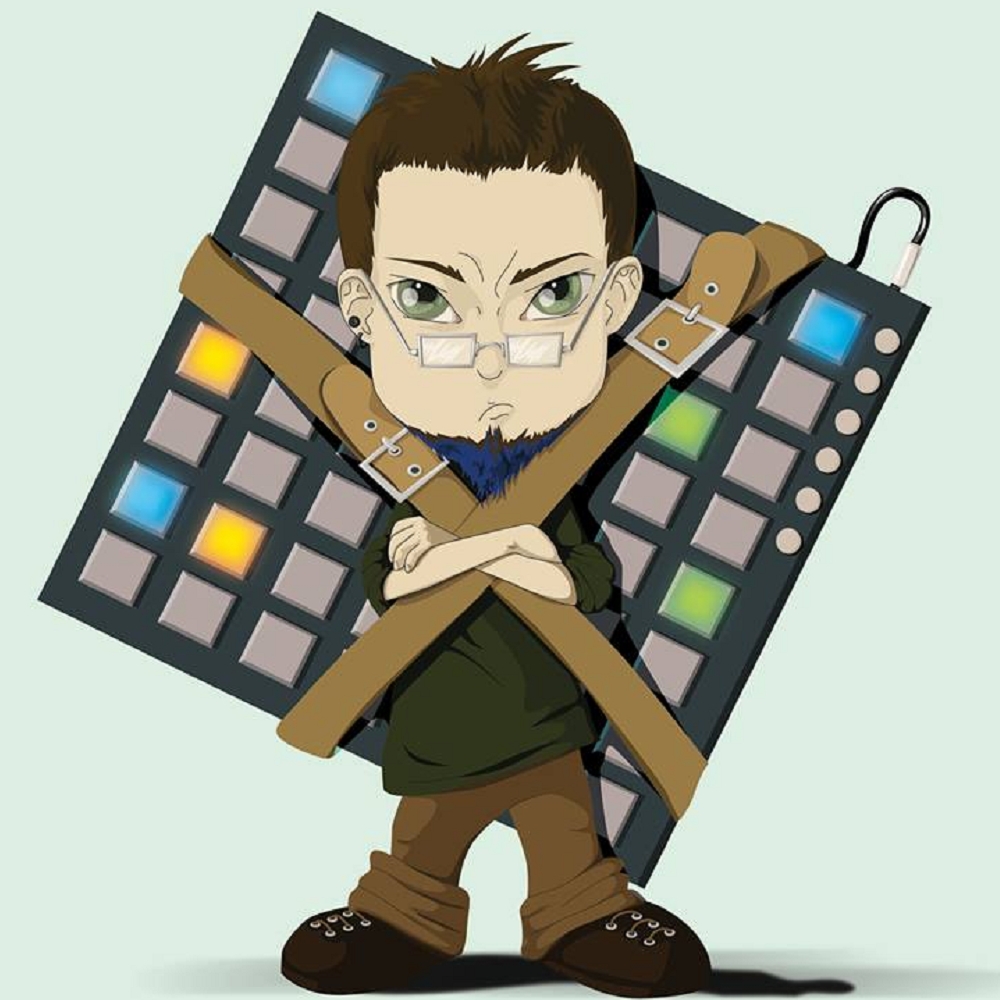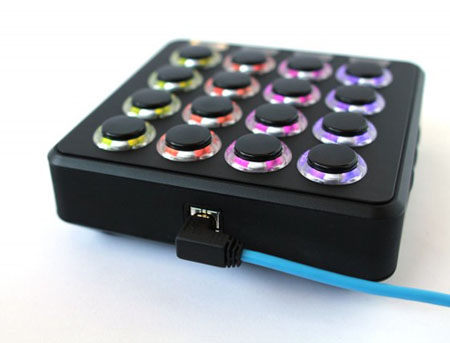-
-

-
Bandesnaci
- 15 May, 2012 in Gear & Tools
Bandesnaci reviews the MIDI Fighter 3D
About a month ago DJ Tech Tools held a contest offering the first MIDI Fighter 3D to come off the production line to whomever made the best performance video using a free Drum Rack for Ableton Live made by controllerist extraordinaire Mad Zach.
After receiving a ton of awesome videos, they decided to give away four MF3Ds instead of one, awarding “Best Performance” to Riccardo Betti’s awesome entry and “Most Creative Video” to my entry.
A couple of weeks after DJTT announced the winners, FedEx was at my door with a cardboard box. So after several days of rigorous testing (read: ‘playing with it and waving the thing around’) I finally think I’ve found out enough about its strong points and its kinks to write a useful article about it. Needless to say, the MIDI Fighter 3D is already a permanent part of my live setup. I find the arcade buttons a joy to play drums on, so it’s currently replacing one of my launchpads.
Although the hardware side of the controller is absolutely awesome and will definitely be a joy for any musical gear-head, the firmware currently has some kinks and glitches. However, I’m sure DJTT will fix each and every one of them with future updates.
A little background info
From the DJTechTools website: “The brand new Midi Fighter 3D combines 16 customizable RGB illuminated arcade buttons with high resolution motion sensors that produce mind-blowing control across each axis of movement. With four banks, six shift buttons and five unique motion controls, the possibilities with the 3D are endless.â€
In layman’s terms, that means that you can move the it around to control sounds and effects. It sends different control messages for left, right, forwards and backwards tilt, as well as right and left rotation (when I say rotation, think of turning a steering wheel). One of the best things about the MIDI Fighter 3D is that you can combine rotation with pressing buttons for different control messages, so that each button can also control a parameter like filter frequency or anything else you can think of (a functionality referred to as Button Pitch). There’s four banks of buttons, so that makes for 64 notes and 70 control change (CC) messages, without counting the super combos DJTT .
The buttons are lit up with RGB LEDs and fully customizable, so you can assign virtually any color to any button for both on (pressed) and off (released). The MIDI Fighter 3D contains an accelerometer, a compass and tilt sensors. There has been some motion sensing technology embedded in different controllers in the past (like accelerometers inside some monomes), but this is the first product to take this to the next level, really centering around motion sensing  and “3D†functionality.
Setting up
I’ve been following DJTechTools for quite a while now, and one of the first impressions I had of them is: “Look at these DIYers!†I had just seen their video promoting the MIDI Fighter Classic, where they were offering the option of shipping  the MIDI Fighter as a kit you could assemble yourself, therefore giving me the impression that this was a community similar to the monome guys. I have since learned differently, but that impression got stuck in the back of my head for some time. I thought the utility would be written in Max/MSP or something and that I’d have to manually connect to the 3D each time I started it, etc.
I was wrong.
I got the MIDI Fighter 3D up and running within 10 minutes of actually receiving the package, and that’s considering I spent 7 minutes unwrapping the thing, putting a photo of it on Facebook and downloading the MF utility from the DJTT website.
Speaking of the utility, it’s straightforward and very easy to comprehend, takes less than 20 seconds to install, connects to and detects the type of MIDI Fighter automatically when started, sends the changes to the controller with a single click and it updates itself, which is more than I could ever have asked for.
Mapping the 3D is equally as easy. The feet on the bottom of the Midi Fighter work to stabilize it in such a way that if you want to tilt it to the right, for example, it won’t rotate or slip and send a different MIDI message than the one you want to map (unless you wave it around like a maniac. But that’s not the controller’s problem then), so assigning a certain movement to a parameter is as easy as selecting the parameter and moving the controller.
I couldn’t possibly be happier with how easy it is to set up.
Capabilities and use
If setting up was a breeze, actually using the MIDI Fighter 3D reveals it as one of the most fun controllers in existence. Before getting my hands on it, I had never finger drummed on arcade buttons. Now that I’ve tried it, I don’t think I can ever go back to rubber pads!There’s obviously no velocity sensitivity, but this only serves to make the playing more equal. If you really want to emulate velocity sensitivity, you can map it to the output of one of the tilt sensors. Crabbing the buttons gives me a speed of playing my samples and one shots that I would never have dreamed of before playing this controller.
The motion sensors are top notch. Any slight movement of the controller on any axis triggers a response from the parameter it’s mapped to, allowing for both face-melting effect changes and really subtle tweaking. It really is what DJTechTools advertise it to be: one of the most expressive controllers on the market today.
And it looks like a toy. The flashing lights and the bright colors that you can customize really add to the experience. You can go eye-candy nuclear or turn all the flashing off, so I think the fully customizable RGB lights will be one of the highest selling points of the MIDI Fighter 3D, maybe even more so than the 3D functionality itself.
A few firmware glitches
At this time, there are a few glitches I’ve experienced with the 3D. Although they were a bit frustrating when I first ran into them, I’m sure these can be fixed with a future firmware update.
For one thing, the 3D automatically does a rainbow animation, shuts down and reconnects itself if  it doesn’t send or receive any MIDI messages for a period longer than 20 minutes. I’ve checked and re-checked this glitch, and I’ve made sure my USB ports don’t automatically turn off. So I don’t know how well this goes with Traktor, but disconnecting and reconnecting any controller while Ableton Live is running, means that that controller is no longer usable until Live is restarted.
The second glitch I ran into is the fact that you can’t play the buttons as notes and tweak the Button Pitch at the same time. Somehow, the 3D stops sending MIDI note off messages if Button Pitch is being tweaked, so the sample playing will just run indefinitely until you press the button again, with Button Pitch deactivated.
Finally, a conclusion
I have to say I absolutely love it. It’s the perfect controllerist toy, and the stuff that matters (the hardware) is tough as a brick and works perfectly. The glitches in the firmware are still there, but they can be fixed. Everything else is top notch.
Another thing I don’t think a lot of people have said yet is that it’s definitely worth the money. Although I didn’t pay a penny for it myself, I’d definitely buy it if I had a spare 250$ lying around or saved up. It makes up for the cost in fun and possibility for expression. It has become an indispensable part of my live setup and I wholeheartedly recommend it.
-


